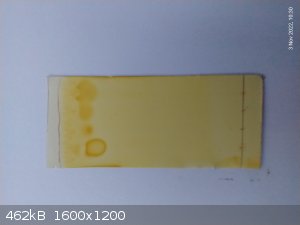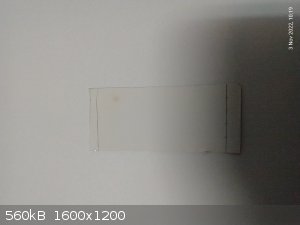Pumukli
National Hazard
   
Posts: 686
Registered: 2-3-2014
Location: EU
Member Is Offline
Mood: No Mood
|
|
TLC challenge
I'm playing with something (an organic preparation) nowadays and made a TLC sheet in the morning.
I was surprised by the outcome of this run and thought I would post it here and ask your opinion!
"If you had this TLC sheet what kind of information could you decipher from the look of it?" This is the "challange"! 
A little help:
- The sheet is "Alufolien Kieselgel 60 F254", Merck, at least 30 years old.
- Eluent was heptane/acetone 4:1
- The sheet was developed in iodine vapours.
- The leftmost ("empty looking") spot is the starting compound.
- The other spots are a "time series" of sampled (then chloroform extracted) reaction mixture spots.
- The time elapsed since reaction start is 2 minutes, 18 minutes and 60 minutes, in this order, from left to right.
What does this sheet tells you? 

Right after I dried the "plate" but before the iodine vapour treatment the sheet looked like this:

|
|
|
Fulmen
International Hazard
    
Posts: 1693
Registered: 24-9-2005
Member Is Offline
Mood: Bored
|
|
Wrong eluent?
We're not banging rocks together here. We know how to put a man back together.
|
|
|
Pumukli
National Hazard
   
Posts: 686
Registered: 2-3-2014
Location: EU
Member Is Offline
Mood: No Mood
|
|
Are you asking me? I thought that I ask and you answer! 
But you are right, the eluent system was not too good, the Rf-s are obviously too high. You can not change this though. Try to decipher more info!

By the way, the expected end product of the reaction is less polar than the starting material. 
|
|
|
Fulmen
International Hazard
    
Posts: 1693
Registered: 24-9-2005
Member Is Offline
Mood: Bored
|
|
Your starting material could have reacted quickly to an intermediate compound that doesn't show up before slowly reacting to the final product. Or
perhaps you spilled coffee on some paper and are pulling our legs :-)
We're not banging rocks together here. We know how to put a man back together.
|
|
|
Texium
Administrator
       
Posts: 4508
Registered: 11-1-2014
Location: Salt Lake City
Member Is Offline
Mood: PhD candidate!
|
|
It tells me you need to re-run it with a less polar eluent, and maybe invest in a 254 nm UV lamp if these compounds are UV active.
|
|
|
CharlieA
National Hazard
   
Posts: 645
Registered: 11-8-2015
Location: Missouri, USA
Member Is Offline
Mood: No Mood
|
|
Just out of curiosity, did you pre-treat the plate in any way, e.g., by heating it for a period? I don't really know how its age would have affected
things, but perhaps the long age and/or no pre-treatment (activation) were a factor.
|
|
|
Pumukli
National Hazard
   
Posts: 686
Registered: 2-3-2014
Location: EU
Member Is Offline
Mood: No Mood
|
|
Fulmen: Good point! (Not the coffee thing, ha-ha.) Hm, I may try next time a more controlled sampling/extraction/spotting. (The different size of the
spots may be (partly) explained by variable volumes of samples and extracting solvent.)
Texium: yes, I plan to use a different eluent next time. Something with more "differentiating power" of targeted compounds. On the other hand I don't
have a proper 250 nm UV light so I used what I found at home: a 360 nm one. The spots were faint but at the exact same position as iodine showed
later.
CharlieA: The pre-treatment meant a quick drying with a hair drier. Just to remove absorbed water.
The age I think shows up on the upper side, right below the front of the solvent front as that "zig-zag" pattern.
Next time I will "pre-run" the empty sheets in pure acetone. This way I may be able to sweep everything "of last 30 year's wear and tear" up with the
front, out of way.
Thanks for the contributions guys!
Keep ideas coming! 
|
|
|
Mateo_swe
National Hazard
   
Posts: 505
Registered: 24-8-2019
Location: Within EU
Member Is Offline
|
|
Maybe make a DIY TLC lamp?
Cheap DIY TLC lamp (SM thread)
|
|
|